Call it what you will—providing a service, creating solutions, enhancing quality of life—at the end of the day engaging an interior design client comes down to making a sale. And for as many reasons as you can assert for why a prospective client should hire you, the prospect may have as many objections. Although it can be challenging at times, you can usually overcome most objections with tact and patience.
No isn’t always the final word
Hiring an interior designer is a big commitment, especially for prospects who have never worked with a designer before. Understandably, they may have some concerns, as well as self-doubts. Raising objections or putting up barriers are defense mechanisms that probably have nothing to do with you personally or your work. They may even be a kind of S.O.S., with the prospect unconsciously signaling, “please help me make this decision.”
When a prospect says no, backs away or raises objections, be understanding, stay engaged, and try to discover what lies behind their hesitancy. During the interior design sales process, some negotiation is to be expected. Sometimes a “no” can be a “maybe, but . . .” Sometimes it may be hiding an “I’m not sure” or an “I need more information.” Patiently probing to get more details or a better explanation about the prospect’s concerns can lead to a positive resolution as well as help to build trust.
Objections reveal pain points
Commonly, prospects have certain expectations and parameters in mind but are reluctant to express them. In interior design sales, these often include issues around budget, pricing, fee scales, and selection and purchase of products and materials. Also lurking in the background may be worries about privacy, disruptions, the design process, the final result of the design itself, project timelines, and delivery dates.
Prospects want reassurance that their wishes will be respected. They want to feel they have some control over the process. Saying no can be one way of trying to exercise control. On the other hand, saying no can be an indication of feelings of inferiority. The prospect may be concerned that their budget or project is too small or that you, the professional expert, will disapprove of their taste or preferences.
Focus on solutions and outcomes
Ignorance and uncertainty are the enemies of interior design sales. They create an information and trust gap that you have to build a bridge across. The best way to do that is to offer solutions to what appear to the prospective client to be insurmountable problems. If the client is telling you they can’t afford your services, collaborate with them to find a compromise that works for both of you. If the client says they’re not ready to make a commitment, review with them the various steps in the design process and the amount of time each is expected to take. Help them to see that the more they delay, the longer they will have to wait to enjoy the improvements they want.
Offer the prospect a vision of how their home or business will be so much better when the project is completed. Take them on a journey through the design process that you will share together. Dissipate their anxiety and uncertainty by providing them with vivid, specific details. If you can, share examples of how other clients overcame their doubts and were so glad in the end that they decided to make the investment in themselves or their business.
Don’t fear the ask
If and when you feel that the prospective client is warming up more to the idea of making a commitment, don’t hesitate to take the initiative. Ask the prospect for the sale, in whatever way you feel most comfortable with. You’re not trying to pressure the client into doing something they don’t want to do or to overreach themselves. You’re simply letting the client know that, based on your discussion up to this point, you are ready and willing to take on their project.
Walk the client through the initial steps of finalizing the commitment. Let them know when you would be available to begin the project. Provide your preferred contact information and invite them to contact you if they have any further questions or concerns. Avoid transactional language such as “do we have a deal?” or “are you ready to sign on the dotted line?”. Instead, ask reassuringly if they understand everything you’ve explained and if they are feeling comfortable with what you’ve discussed. Let the acceptance evolve naturally from your efforts to meet the prospect’s needs and qualm their concerns.
In other words, be persistent without being pushy.
Follow up and close
Having created some momentum toward finalizing the interior design services sale, follow up with the prospect in a day or two. Don’t rush them, but stay in contact and stay positive. Let them know that you are putting together a formal proposal based on your discussion. Ask them when would be a convenient time for them to review it, without obligation. Let them see that you are serious, professional and reliable. Continue to work on building trust.
If the prospect is satisfied with the proposal, then it’s time to say something like, “Are we in agreement, then?” If they say yes, at that point you can provide them with your Letter of Agreement or Contract and officially close the sale with a signed commitment. And of course, be sure to thank them for saying yes.
